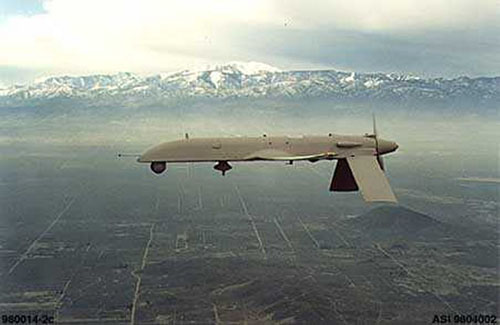Gnat 750
Abraham Karem was about to change the world, but he had no idea.
It was 1980 in Hacienda Heights outside Los Angeles. Karem, a then-forty-three-year-old aeronautical engineer born in Baghdad and raised in Israel, was spending much of his time in his garage. The garage doubled as headquarters for Karem’s own aerospace design firm, Leading Systems, Inc. There Karem was building something. Something tube-shaped with wings. Sometimes Karem would sit in the living room tinkering with the circuits and black boxes of electronics. A year later the project had grown and, according to a newspaper account, “spilled into the guest room.” It was a remote-controlled airplane: a drone. Karem called it “Albatross.” His wife called it funny.
So did the Pentagon, when Karem flew the Albatross in front of a group of military observers at Dugway Proving Ground in Utah. Still, the drone managed fifty-six hours of flight between crashes—a big improvement over existing robot aircraft.
Since World War II the military had used rudimentary drones as aerial targets for air defense gunners, and sometimes as photo-reconnaissance craft. Previous drones had looked like miniature versions of manned planes. By contrast, Albatross wasn’t much to look at. The military dismissed it as “skinny.”
And that would have been that, if not for an unlikely rescuer: the Defense Advanced Research Projects Agency (DARPA), the military’s fringe science incubator.
DARPA was formed in 1958, in the months following the Soviet Union’s successful launch of Sputnik, Planet Earth’s first man-made satellite. DARPA was supposed to gamble a little cash on seemingly unlikely research projects, in hopes of occasionally scoring big with a major technological breakthrough.
Karem’s skinny drone sure looked unlikely. It took a few years, but in 1984 DARPA ponied up $40 million for the robot. Karem rented office space in nearby Irvine and started hiring. His company would eventually grow to number 120. The seventh employee Karem hired was Frank Pace, an engineer then in his early thirties.
Two years after his DARPA windfall, Karem’s improved Albatross was ready. “Amber,” as he renamed it, was fifteen feet long, had a twenty-eight-foot wingspan, and weighed 740 pounds. Its four-cylinder, sixty-five-horsepower engine drove a tail-mounted “pusher” propeller. It carried enough fuel for thirty-eight hours of flight. It also included what were, for the time, sophisticated sensors.
“A high-altitude, long-endurance, high-Reynolds number type of airplane,” is how Pace described Amber. In aviation, the “Reynolds number” is a way of quantifying how air moves over a wing. A high-Reynolds airplane has a long wing and flies slow. This particular high-Reynolds plane was also loud—like “a lawn mower in the sky,” according to one observer. The noise isn’t necessarily what killed Amber. But it certainly didn’t help. After showing off Amber at the San Diego Air Show in 1988, Karem entered Amber into an army competition for a short-range reconnaissance drone. By then he had built thirteen Ambers.
“We lost that program,” Pace recalled. Worse, “the company was essentially blackballed,” he added. Not only was Amber noisy, its creator could be “abrasive,” according to aviation historian Greg Goebel.
With Leading Systems, Inc., in trouble, Karem and his engineers designed a simpler, cheaper version of Amber they called the Gnat 750 and offered it to the Turkish government, but Ankara didn’t bite. The CIA did, though. Agency director James Woolsey knew Karem personally and was eager to test the Israeli’s new robot. The CIA purchased five Gnats.
Foul-ups were frequent in the agency’s early experiments with its new toys. One Gnat flew headlong into a gust of wind that reduced its airspeed to zero—it was, in essence, hovering—and convinced the onboard computer that it had landed. The computer dutifully shut down the Gnat’s engine and it tumbled to the ground.
With its DARPA money all spent and no further paying customers in the offing, in 1990 Leading Systems went into bankruptcy. Its drones and its people were up for grabs. In an act of profound industrial foresight, General Atomics, a San Diego company most famous for making nuclear reactors, snatched up all of Karem’s robot designs plus ten of his engineers, including Pace. Karem himself signed on as a consultant.
In January 1991, during the bombing campaign preceding the ground war to liberate Iraqi-occupied Kuwait, U.S. Air Force and Navy warplanes searched in vain for Iraq’s mobile Scud missile launchers, hiding out in the vast desert of western Iraq.
What the military needed was a reconnaissance system that could loiter for hours over the desert, patiently scanning for movement. The navy possessed a handful of Israeli-made Pioneer drones, launched from the battleship Wisconsin, but their endurance, and therefore their usefulness, was limited. So the Pentagon decided to give bigger, longer-range drones another chance and set up an office under navy supervision. Right before Thanksgiving in 1993 the office asked drone manufacturers for proposals. The deadline was in eight days, which Pace said was crazy.
What Pace apparently didn’t know was that the CIA intended to send the new spy ’bots straight to the Balkans to monitor the rapidly deteriorating political situation in Bosnia. The agency needed drones now.
The General Atomics team pitched Karem’s Gnat 750, which barely survived as a viable project after Turkey finally agreed to purchase copies. On a whim, the engineers added another option to their proposal. They sketched a larger Gnat 750 with a bulbous nose for more sensors and equipment. “That’s the one they actually selected,” Pace recalled.
In January the navy-led office offered General Atomics a $5-million contract for two copies of the sketched robot, with a quieter and more powerful engine than that on the Gnat.
And that’s how the Predator, the world’s leading “killer” drone—and a weapon that helped give rise to a whole new kind of warfare—was born.
